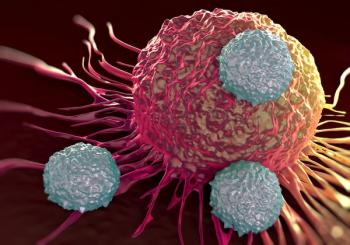
Oncology NEWS International
- Oncology NEWS International Vol 9 No 11
- Volume 9
- Issue 11
Breakthrough Pain Is Frequent and Often Unpredictable
LONDON-A prospective survey of cancer patients admitted to a hospice shows that breakthrough pain is “frequent, short lasting, often unpredictable, and not necessarily related to chronic pain, making treatment difficult,” said Giovambattista Zeppetella, BSc, MRCGP, of the Palliative Medicine Service, St. Joseph’s Hospice, London.
LONDONA prospective survey of cancer patients admitted to a hospice shows that breakthrough pain is frequent, short lasting, often unpredictable, and not necessarily related to chronic pain, making treatment difficult, said Giovambattista Zeppetella, BSc, MRCGP, of the Palliative Medicine Service, St. Josephs Hospice, London.
Previous studies have characterized breakthrough pain in patients at cancer centers, pain clinics, and hospice home care. The current study explored the prevalence and characteristics of breakthrough pain in terminally ill cancer patients admitted to a hospice.
For this study, breakthrough pain was defined as a transitory exacerbation of pain experienced by the patient who has relatively stable and adequately controlled baseline pain.
During the study period (February to August 1998), there were 432 hospice admissions, and 414 of these were patients with cancer. Of the cancer patients, 33 (8%) were excluded because they were unable to answer questions due to dementia, confusion, or final stage of disease. Another 136 patients did not have chronic pain on admission.
Of the 245 eligible patients with chronic pain, 218 reported breakthrough pain. Most episodes were tumor related; 11% were unrelated to the patients reported chronic pain.
The most common sites of breakthrough pain were the abdomen (30%), lower limb (19%), back (16%), and chest (12%). Patients had an average of 7 episodes a day of breakthrough pain (range, 1 to 14) (J Pain Symptom Manage 20:87-92, 2000).
About half of the incidents of breakthrough pain occurred suddenly; most were unpredictable; and 17% were due to end-of-dose failure of scheduled analgesics, the investigators reported.
Episodes were generally of short duration, with 73% lasting 30 minutes or less. Neuropathic pains were particularly brief, with 91% lasting 30 minutes or less, compared with somatic and visceral pains (69% and 62%, respectively), the authors said.
Patients said their breakthrough pain was best relieved by analgesics (57%) or lying still (32%), with some patients naming both factors (17%), but in 14% of episodes, the patient could cite no factors that relieved the pain.
The patients with breakthrough pain were receiving nonopioid analgesics (34%), so-called weak opioids (23%), or so-called strong opioids (64%) for their chronic pain. Of those on strong opioids, 99 were taking long-acting agentsslow-release morphine or transdermal fentanyl (Duragesic) and of these patients, 43% were not prescribed rescue medication for breakthrough pain.
Short-Acting Oral Morphine
The investigators emphasized that the medication used to treat breakthrough pain should be absorbed quickly and produce a rapid onset of analgesia with minimal adverse events. The medication should be instantly available, they added, which may not be possible if the institution keeps controlled drugs locked away.
They suggested that because of the rapid onset and short duration of breakthrough pain, short-acting oral morphine, the most frequently prescribed rescue medication in this study, may not be appropriate. It can take up to an hour to produce analgesia, which may then last for up to 4 hours.
Satisfaction Levels
When the patients were asked if they were satisfied with their pain control, 78% of those with chronic pain but no breakthrough pain said they were satisfied vs 25% of those with breakthrough pain. The dissatisfied patients had significantly more occurrences of breakthrough pain (292 vs 69 among those with breakthrough pain who were satisfied with their pain control).
This underlines the importance of specifically including an assessment of breakthrough pain in the overall assessment and management plan, the researchers noted.
The investigators pointed out that 8% of the original 414 cancer patients were unable to participate in the survey because they were too unwell. Most of these patients had been prescribed opioids, making it likely that at least some of them were having breakthrough pain.
These patients require careful monitoring to identify breakthrough pain; clinical signs may be subtle and difficult to identify, even for experienced hospice staff, they said.
The findings also highlighted the variability in the way researchers define breakthrough pain. Some studies include only pain of moderate intensity or greater, but in this study 78% of the 225 patients reporting mild to moderate pain said they were dissatisfied with their pain control, suggesting that mild to moderate pain should be included in the definition of breakthrough pain.
Perhaps an appropriate working definition is that breakthrough pain, like chronic pain, is whatever the patient says it is and occurs whenever the patient says it does, the researchers commented.
The other authors of the study, both from St. Josephs Hospice, were Catherine A. ODoherty, PhD, MRCP, and Silke Collins, MD.
Articles in this issue
about 25 years ago
Joe & Ali Torre Lead ‘Two Against One’ Prostate Cancer Campaignabout 25 years ago
Efforts to Reduce Tobacco Deaths May Fail in the Short Termabout 25 years ago
Data Published for First-Line Irinotecanabout 25 years ago
Manufacturing Capability a Factor in Success of New Biologicsabout 25 years ago
Report Finds States Not Using Tobacco Funds for Preventionabout 25 years ago
NCI Intramural Program Challenged to ‘Reinvent Itself’about 25 years ago
Surgery Supported for Recurring Colorectal Cancerabout 25 years ago
Breast Cancer Stamp Funds $6.7 Million in 2-Year NCI Grantsabout 25 years ago
Human Side of Cancer Offers Insights on Coping With the DiseaseNewsletter
Stay up to date on recent advances in the multidisciplinary approach to cancer.





